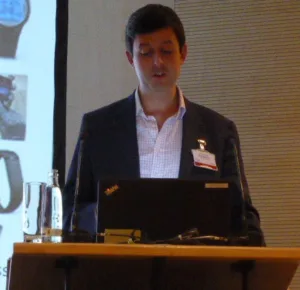We last talked to Paul Cain of FlexEnable at MWC 2016 (FlexEnable Curves an LCD Around the Wrist), and he was presenting at the IDTechEx Show on the topic of ‘Ubiquitous Displays and Sensors’.
Wearable technology is transforming lives; IDTechEx forecasts a market size of 3 billion wearable sensors and 1 billion wearable displays by 2025. However, there is some debate as to which form factor will ‘win’: multi-purpose, like smartwatches, or single use, like fitness trackers. Unfortunately, Cain didn’t go into much detail on the subject.
FlexEnable is a technology developer, but does not produce products. Instead, it licenses IP. One of its recent developments was a flexible O-TFT film: a 50µm-thick sheet of plastic about the size of a sheet of paper, holding 1.2 million transistors. This sheet was produced in a low-temperature (<100°) process and has a 0.25mm bend radius. It is being used in products now, such as Popslate’s electronic paper display iPhone cover.
Another product – or, more accurately, concept – using the O-TFT film is FlexEnable’s own flexible ‘organic’ LCD display (see linked article FlexEnable Curves an LCD Around the Wrist). However, although the display is conformable (i.e. it can be bent just once in manufacture), it is not truly flexible. OLED is needed for this.
Cain also mentioned a flexible large-area fingerprint sensor that FlexEnable has built, and which was on show at the event. It is 860 x 860mm and was developed with ISORG.

